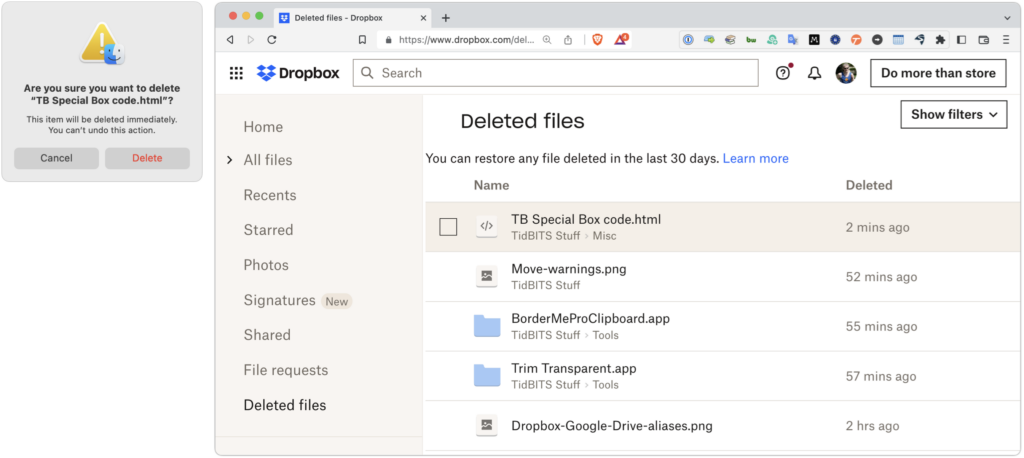Cloud storage services—such as Box, Dropbox, Google Drive, and Microsoft OneDrive—are an attractive option when desiring a centralized spot for shared data without the upfront cost or required maintenance of a network-attached storage device. Cloud storage allows individuals to access the same files on multiple devices, and also significantly enhances collaboration by allowing several people to work on the same file.
All cloud storage services provide simple web-based interfaces that look and function the same for everyone, regardless of platform. Unfortunately, these interfaces are clumsy to use compared to working with the same files in the Mac’s Finder. When you install the cloud storage services’ Mac apps, however, you can utilize their deep integration with the Finder.
After the software is installed, look to the Locations portion of your Finder window sidebar, where you will have access to everything in your cloud storage, just as though it were on an external hard drive connected to your Mac. Here you can rename and move files, add folders, and perform other basic Finder tasks. Additionally, the services’ apps install menu bar items to open settings, activity, and other controls. Knowing that cloud storage is not the same as an external hard drive, however, you will want to take note of a few facts when using cloud-based data in the Finder.
Data May or May Not Be Stored on Your Mac’s Drive
All cloud-based files are either online-only (so you’ll only see a placeholder icon on your Mac) or offline, which means a copy of the file exists on your Mac. Online-only files and folders have a cloud icon next to their names in the Finder; offline files lack that icon.
When you double-click an online-only file, the service’s Mac software downloads it in the background so it can open in the appropriate app. Online-only files do not take up any space on your Mac’s drive until you open them. Of course, when on an airplane or somewhere without connectivity, you cannot open online-only files.
You can control which files and folders are online-only and which are offline. To bring content down to your Mac, Control-click the file or folder and look for commands like “Download Now” or “Make Available Offline.” To remove downloads, use commands like “Remove Download” or “Make Online-Only.”
All Your Files Live In ~/Library/CloudStorage
Offline copies of cloud-based files are stored in your Mac’s home folder, in a folder called “CloudStorage,” within the hidden Library folder. (To see the Library folder, open the Finder’s “Go” menu and press “Option.”) That folder lives on your Mac’s internal drive, which unfortunately may not have sufficient space to store offline copies of all your cloud-based data. And only Microsoft OneDrive lets you store offline copies of your files on an external hard drive; it is not possible with Box, Dropbox, or Google Drive. (If you manage terabytes of offline files, particularly for audio- or video-editing work, check out LucidLink’s services.)
Dragging Files Moves Rather than Copies
Dragging a file from your Mac’s internal drive to an external hard drive or network drive copies the file, because it’s going to a different volume. But dragging a file out of Google Drive, for example, moves it—just as though you dragged a file from one folder on your internal drive to another.
Moved or Trashed Files Remain Online, at least Temporarily
When you move an online version of a file from the cloud storage service on your Mac to another location on your Mac’s internal drive, it will end up in the trash equivalent of the service’s website. Cloud storage services generally retain such files for a period of time—often 30 days—before they are erased for good.
When you delete a cloud-based file in the Finder, it will also end up in the service’s online trash equivalent—but what happens on your Mac varies by service, so testing with a sacrificial file is worthwhile. For instance, if you delete an offline file in Dropbox, it moves to the Mac’s Trash; if you delete an online-only file in Dropbox, it disappears from the Mac rather than moving to the Trash (but can still be found in Dropbox’s Deleted Files folder on the Dropbox website). In contrast, deleting either type of file from Google Drive moves it to the Mac’s Trash, and puts it in Google Drive’s online Trash folder.
Share Files and Paths, not links, with Colleagues
While all cloud storage services let you Control-click a file and copy a link to send to co-workers, finding the file again in the future can be difficult for them. Instead, help colleagues learn where files are located in a shared cloud-based file structure by sending them the path to the file: the full list of folders containing the file. Find the path by selecting “File” in the Finder, then Option-click the “Edit” menu, and choose “Copy ‘MyFile’ as Pathname.” The start of the path is specific to your Mac, so delete that and leave the rest.
Searches May Work Poorly for Online-Only Content
Spotlight and other content-based searches cannot index content in online-only files, and thus they are not able to find files based on content searches. However, some of the cloud storage services offer such searches from their Web interfaces, finding all files containing the search terms even when the files are set to online-only on your Mac.
Filename searches in Finder windows should work regardless of online-only/offline state but search the “This Mac” scope for best results. You may also find success with third-party search utilities like EasyFind and Find Any File.
Backups Work Only for Offline Content
Mac backup systems like Time Machine and Backblaze cannot back up online-only files because they do not actually exist on your drive. At best, these apps will show the placeholder for the file but won’t back up its content. That said, cloud storage systems do automatically protect data against drive failure or other problems in the cloud, and any shared data that a collaborator deletes from his or her Mac should be maintained in his or her online trash.
We would argue, however, that it is easy to lose or corrupt cloud-based data, and so creating a local backup can provide an essential fallback or welcome peace of mind. To ensure that your cloud-based files are backed up alongside your other files, you must make sure they are stored offline long enough to get into your backups: select top-level folders, make them offline, and wait until everything has been downloaded and backed up. Take note of new files added by other devices or people, as they may be online-only by default and thus not included in your backups. And if you need the space back, you can always return some folders to being online-only.
For backup of an organizational cloud storage account, it might make more sense to use a service like Backupify, CloudAlly, or CubeBackup, or to rely on something like a Synology NAS device with Cloud Sync. Please feel free to get in touch with us to learn more about these services, or with any questions you might have regarding your cloud storage.
(Featured image by iStock.com/Galeanu Mihai)





